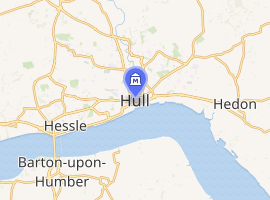Hull Maritime Museum
The Hull Maritime Museum is a museum in Kingston upon Hull, England, that explores the seafaring heritage of the city and its environs. The museum's stated mission is "To preserve and make available the maritime history of Hull and east Yorkshire through artefacts and documents".[1]
 | |

| |
| Established | 1912 |
|---|---|
| Location | Kingston upon Hull |
| Coordinates | 53.7439°N 0.3386°W |
| Type | History |
| Website | Hull Maritime Museum |
History and site

The museum, originally known as the Museum of Fisheries and Shipping, opened in 1912 in Pickering Park.[2] It moved to its current location, the Dock Offices building, in 1974.[3] The Dock Offices building is so-named as it is the former headquarters of the Hull Dock Company, which operated all docks in Hull until 1893.[3] Built in 1872, it is a Grade II* listed building[4][5] and a striking example of Victorian architecture.[3] The building stands in Queen Victoria Square, opposite the Queen's Gardens, in Hull's city centre. Hull City Council currently operates and maintains the museum.[3]
In January 2020 the museum is temporarily closing at the beginning of a £11 million programme of conservation and modernisation. It is scheduled to re-open in 2023 as the centrepiece of Hull's "Maritime City Project" and with an additional exhibition floor following the relocation of storage, research and conservation centre in the adjacent Dock Office Chambers.[6][7]
Exhibits and collections
The period of time covered by the exhibits extends back to the Bronze Age and through the Middle Ages, but the museum primarily concerns itself with Hull's maritime history from the 19th century onward.[2] The museum's exhibits are arranged along the following primary themes:[2][8]
Arctic whaling heritage
The museum dedicates an entire gallery to Hull's whaling industry, which peaked in the early 19th century. Dozens of vessels ventured into the Arctic waters (particularly those around Greenland) during this period. The gallery contains personal effects, shipboard items, models, and artwork (including the largest collection of scrimshaw in Europe),[2] and Inuit artifacts, including a kayak.
North Sea fishing industry
The city's fishing industry rose to prominence in the mid-19th century, and one gallery of the museum documents the history of the industry as it expanded from the North Sea into more northerly waters. This gallery makes use of models of the industry's various ocean-going vessels, from simple cobles to large trawlers.[2]
Maritime trade
Hull's tradition of ocean-going commerce dates from the Middle Ages and has historically targeted the nations of Scandinavia and the Baltic Sea. The Court Room in the Hull Docks building, once for use by the Hull Dock Company's shareholders and now the venue for temporary exhibitions, also pays hommage to Hull's commercial past and present. The room houses a frieze containing the coats of arms of the cities with which Hull has historically had trade relations.[3]
Online: Hull and the sea
As part of its online Hull Museums Collection, Hull City Council launched the Hull and the sea website in 2008. The website allows users to virtually browse the maritime museum's collection, from works of scrimshaw to descriptions and images of the seagoing vessels from the city's past.[9]
Hull City of Culture 2017
During Hull's year as UK City of Culture the Maritime Museum played a prominent role in the opening three-month season entitled Made in Hull. At the opening event during the first week the building was one of three in Victoria Square which had multimedia projections displayed on them, attracting over 300,000 visitors.[10] Throughout the three-month season the Museum hosted a multimedia installation called Bowhead depicting a bowhead whale.[11][12]
See also
- Arctic Corsair, former trawler, now a museum on the River Hull in Hull
- Spurn Lightship, former lightship, now a museum in Humber Dock, Hull
References
- "Hull Maritime Museum". UKMCS. United Kingdom Maritime Collections Strategy. 2007. Archived from the original on 10 June 2007. Retrieved 3 August 2007.
- "History Around Hull: Hull Maritime Museum". My Learning: Learning with Museums, Libraries, and Archives in Yorkshire. My Learning. 2006. Retrieved 3 August 2007.
- "Hull Maritime Museum". Hull City Council. Hull City Council. 2007. Archived from the original on 16 April 2007. Retrieved 3 August 2007.
- Pevsner, Nikolaus; Neave, David (2002) [1972]. Yorkshire: York and the East Riding: The Buildings of England (2nd ed.). Yale University Press. ISBN 0-300-09593-7.
- Historic England. "Hull Maritime Museum and Adjoining Railings (1219019)". National Heritage List for England. Retrieved 14 August 2013.
- "Hull Maritime Museum". Yorkshire's Maritime City. Hull City Council. Retrieved 20 December 2019.
- "Hull's Maritime Museum will be closed for three years". HullLive. Hull Daily Mail. 19 December 2019. Retrieved 20 December 2019.
- "Hull Maritime Museum". The Hull Website. 2007. Archived from the original on 28 September 2007. Retrieved 3 August 2007.
- "Hull and the sea". Hull Museums Collection. Hull City Council. 2008. Retrieved 18 November 2014.
- "Over 300,00 attend Hull City of Culture opening". ITV News. Retrieved 12 January 2017.
- "Bowhead at Hull Maritime Museum, Hull 2017 City of Culture". BBC Arts. Retrieved 18 January 2017.
- Young, Angus (5 January 2017). "Family of whales brought to life for amazing City of Culture show". Hull Daily Mail. Archived from the original on 18 January 2017. Retrieved 18 January 2017.
External links
| Wikimedia Commons has media related to Hull Maritime Museum. |